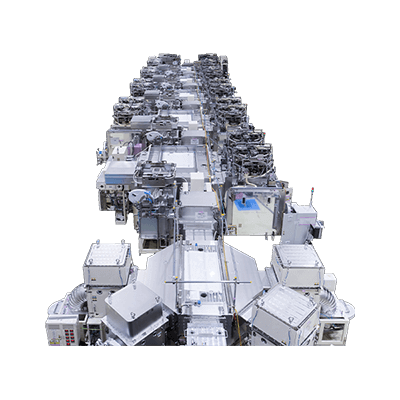What Is Deposition Equipment?

Deposition equipment, as the name implies, is equipment used to create films.
Various types of deposition equipment have been developed depending on the thickness and purity of the thin film, and whether it is organic or inorganic. For example, high vacuum deposition equipment is used when a highly pure and uniform film is required, such as for semiconductor-related materials.
On the other hand, for products such as films, which require mass production over a large area, roll-to-roll or batch methods are chosen. Spin-coat and inkjet deposition equipment are also used for deposition by drying the solution after it is applied.
It is important to select the appropriate type of deposition equipment according to the application and conditions. This selection will enable the development of more efficient and higher quality products.
Uses of Deposition Equipment
Deposition equipment for high-purity metal oxides is suitable for deposition of high-purity, thin, uniform metal oxides for semiconductor parts, etc. High-vacuum deposition equipment is used. The same equipment can also be used for deposition of thin metal reflective films on the surface of car headlamps, camera lenses, etc., which suppress light reflection.
On the other hand, roll-to-roll or batch deposition equipment is suitable for products that require mass production, such as plastic films and thin metal foils. These products have thicknesses on the order of micrometers.
In addition, organic semiconductor thin films, known as printed electronics, such as organic EL materials, are produced using inkjet deposition equipment.
Principle of Deposition Equipment
There are two types of deposition equipment: high-vacuum deposition equipment and mass-production deposition equipment, such as roll-to-roll methods.
1. High-Vacuum Deposition Equipment
There are two types of high-vacuum deposition equipment: physical vapor deposition (PVD) and chemical vapor deposition (CVD). In evaporation, the film material is heated to volatilize and adhere to a substrate mounted on top of the equipment to grow the film.
In the sputtering method, particles accelerated by voltage are hurled at the film material, and the flying particles adhere to the substrate attached to the top of the equipment to grow a film. Both methods use high vacuum conditions to prevent oxygen and other substances contained in the atmosphere from entering the film, thereby achieving a highly pure film.
2. Deposition Equipment for Mass Production
The roll-to-roll method is a method in which a film is applied to a rolled substrate while it is being rotated. This method is suitable for mass production and large-area film production.
To produce a uniform film, the viscosity of the sample solution must be kept within a certain range. Since this viscosity varies depending on the rotation speed and physical properties of the sample, it is important to consider the viscosity of the sample when examining deposition conditions.
Other Information on Deposition Equipment
Deposition Equipment and Machines Used in Conjunction With Deposition Equipment
There are four types of equipment used in conjunction with deposition equipment: vacuum pumps, substrate heaters, etching equipment, and inspection equipment.
1. Vacuum Pumps
Deposition equipment requires a high vacuum to produce a high-purity film. Vacuum pumps are responsible for creating a high vacuum by removing air from the deposition equipment. This prevents impurities from mixing into the film, resulting in the creation of high quality films.
2. Substrate Heater
Substrate heaters are machines that regulate the temperature of substrates used in the deposition process. By heating the substrate to a temperature suitable for deposition, film adhesion and uniformity are improved, resulting in higher quality films.
3. Etching Equipment
Etching is necessary to form a predetermined shape or pattern on the substrate after film deposition. Etching equipment has the capability to selectively remove a portion of the film using chemicals or plasma. Fine circuit patterns, etc., will be formed.
4. Inspection Equipment
After film deposition is complete, quality inspection is critical. Inspection equipment is used to check film thickness, uniformity, adhesion, and other qualities. This enables early detection of defective products and improvement of the manufacturing process, thereby increasing overall production efficiency.